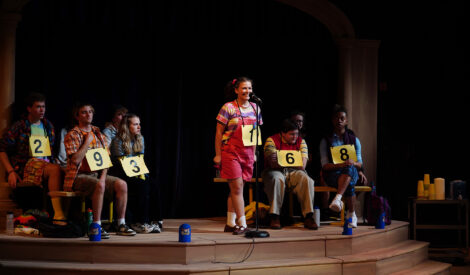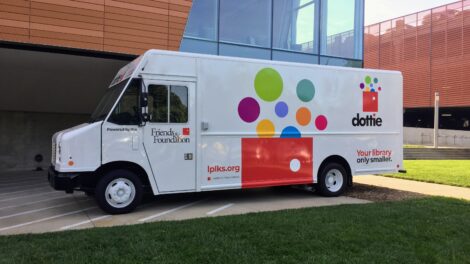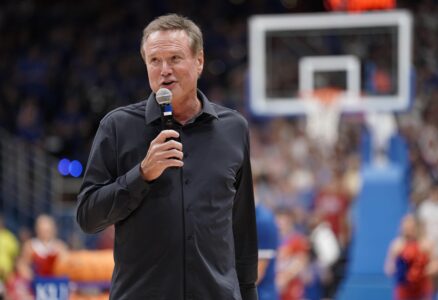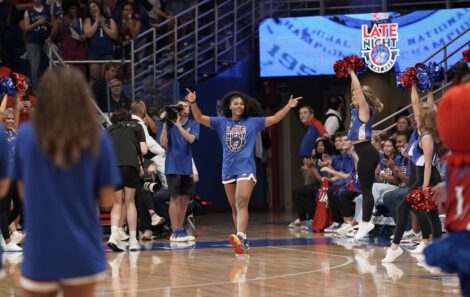KU GATEWAY: For Girod, Gateway project started with a question: How can we use the stadium more?
$750M project will 'benefit ever element of this community in one way, shape or form'
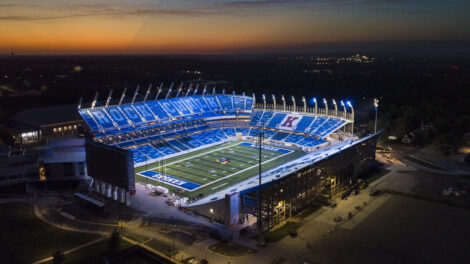
David Booth Kansas Memorial Stadium on Monday, July 28, 2025. Photo by Nick Krug
There has long been a multimillion-dollar chicken or the egg question at the University of Kansas and its football program.
KU Chancellor Douglas Girod got immersed in it even before his first day on the job. A couple of weeks before Girod’s July 2017 start date, the athletic director at the time announced that plans for a $300 million football stadium renovation would soon be released. A $50 million gift from KU alumnus David Booth would soon follow to prime the pump.
In short, the excitement of a new football stadium was in the air. What landed on the chancellor’s desk, however, was a different matter. It was that old chicken or the egg question.
“You know, when I started, we didn’t have the indoor facility, we hadn’t redone the practice facility,” Girod remembered in a recent interview with the Journal-World. “We weren’t even ready for a stadium, quite honestly. We needed those things in place before we could even think about a stadium, because you had to be able to have a team, too.”
In other words, a $300 million chicken or the egg question: Does the stadium come first or the team?
Ultimately, the team did. After a couple of coaching changes, a couple of athletic director changes, a new indoor practice facility, locker room upgrades, and revamped recruiting, KU now finds itself with a team that has been to a bowl game two out of the last three years.
Today — eight years after that 2017 announcement — KU has the stadium too. A $448 million renovation of David Booth Kansas Memorial Stadium is largely complete, and will be on full display for KU’s first game of the season, Aug. 23 against Fresno State.
Girod is betting the sight will put to rest the age-old question: Forget the chicken. Forget the egg. Step up to the buffet.
“I think they are going to be blown away from the moment they walk up to the site because there is not a piece that hasn’t been touched,” Girod said of fans and the upcoming day. “We went from three elevators — one that was broken all the time — to 14 elevators and two escalators.”
“The amenities are better than Arrowhead,” Girod said, comparing it to Kansas City’s NFL stadium. “I mean it. I’m not kidding.”
More days, more ways
Come to find out, there was something else besides wins that Girod needed to become fully comfortable with before moving ahead on the stadium project. He never doubted the need for an improved stadium. The need for an upgrade has been clear and “probably needed to be done 30 years ago, quite honestly,” he said.
No, the question that was gnawing at his gut was how do you spend this much money on a facility that maybe will only be in use for eight or nine major events per year?
He and other KU leaders ended up answering that question with a question.
“Rather than using it eight or nine days a year, why not use it 200 days a year to also support a conference center?” Girod asked.
The State of Kansas said yes, and in a loud way. The state provided $85 million in funds through both economic development money and infrastructure grants that came to the state during the pandemic recovery programs. That $85 million was never part of the equation when KU was thinking of doing only a football stadium renovation.
The state money has allowed the completed project to become much more. The north end of the stadium has a conference center built into it. The center includes a 1,000-seat banquet room that will be the largest in the city when it opens later this year.
The conference center and stadium space share many synergies, which Girod said was one of the lightbulb moments that caused him and other KU leaders to believe they could do something bigger than a traditional stadium remodel.
For example, a stadium already requires a large amount of kitchen space to meet the concessionaire needs of game day. Now, the kitchen space can also be used to serve meals to convention-goers. Another synergy: Across the hall from the banquet room is a luxury seating area that looks over the north end zone of the field. On non-game days, that luxury area can be used as a gathering area for convention attendees to mingle, network, and share a drink before they step across the hall to attend their meetings.
Plus, there are more mundane matters: One parking lot will be able to serve two uses. The same goes for the elevators, the restrooms, and a whole host of other infrastructure.
It all adds up to an equation that means the stadium will be used more days and more ways.
Girod said he is intent on seeing that happen. The university has selected the Oak View Group, one of the largest operators of convention centers in the country, to manage the operations of the stadium and the conference center.
Additionally, KU has made an important change in how it oversees the stadium. In the past, Kansas Athletics generally had the final word on any matter involving the stadium. Now, the chancellor’s office has assumed oversight of the stadium, and Girod said he’s sent the message his office is going to put it to use. The athletic department has bought into the idea in a big way, and will be a great partner, Girod said.
“I know another institution where their AD and coaches won’t allow the university to use their spaces for anything else, and they have turned away some pretty big opportunities,” Girod said. “This is a partnership. You can’t be in that position. We all need to share what we have.”
On more than a hundred nights per year, what KU is likely to have is a convention or a conference of some sort. The second phase of the Gateway project will include a hotel connected to the conference center, a thousand spaces of underground parking, restaurants, student housing, a few private condos and other amenities. Those additional components will bring the total price tag of the Gateway project to about $750 million, with a private development group and state and local tax incentives serving as major funding sources for the additional development.
The Oak View Group will use those new amenities to attract conventions and conferences to the site, but Girod is also betting there is one more synergy that will help the project. Perhaps the ultimate synergy in this project is that KU faculty members and staff belong to an almost endless number of associations. As a professor and an expert in a field, you often belong to multiple associations in that field of study. Almost all of those associations have an annual conference, and Girod thinks KU will end up hosting its fair share once it has the facilities to do so.
But if, for example, the annual blowout for the American Anthropological Association doesn’t necessarily excite you, Girod said KU is thinking much broader about events that the entire stadium can host. He said concerts are very much in the game plan for the revamped stadium.
“Lawrence is a great music town and incredible arts scene,” Girod said. “Plus, when acts are moving from the East Coast to the West Coast, we are a good stop. It might be a Thursday night instead of a Saturday, but that will be OK.”
The big view
Girod has toured the stadium site many times as it has been in various stages of construction, and usually finds something that excites him. Recently, it was a perch atop that new conference center.
“The best view of Kansas might be standing at the top of the north end zone,” Girod said. “It will pop your eyes. It really will.”
It may be appropriate that Girod has spotted that view because he’s been the person who has most frequently said you have to view this project broadly to fully understand what it can offer.
It is about far more than football, he says.
First, there is student recruitment. There is a reason university leaders have dubbed the project the Gateway district. They intend for nearly every potential student and their family to come through the district as they start their tour of campus. The relatively new, multimillion-dollar Jayhawk Welcome Center is also on the northern end of campus, making the stadium basically within eyesight of the welcome center.
When the east side renovations are completed — KU leaders are roughly projecting in the next two to three years — the project will include a new plaza area that Girod thinks can become a campus quad for a university that doesn’t really have one. Plus, there will be restaurants, new student housing and the promise of fun and excitement that can occur at the site.
All that is important, he said, if you want to attract students during a time period when competition for students has become more intense as the sizes of graduating high school classes have fallen significantly.
“We are in the experience business, if you think about it,” Girod said of the university. “It is your educational experience, but also your campus life experience.”
He noted the schools in the Southeastern Conference — the powerhouse football conference — are becoming very good at using campus experiences to recruit new students. As the competition for students gets stiffer, the wow factor needs to get bigger.
Then, there is the view of what this project can do for Lawrence. Girod is hoping that community members are starting to get an idea of how big of a boost this can be to the Lawrence economy. When phase II is complete, the total amount of money invested at the site will be about $750 million.
“I hope the community, at the end of the day, will appreciate that this has been the biggest investment in this community in modern history,” he said. “We are pushing a $750 million investment that will benefit every element of this community in one way, shape or form.”
Of that money, Girod noted about $350 million of it is coming from KU donors “who are mostly not in Lawrence.”
That said, it is also true part of that investment is scheduled to come from local governments that will forgo collecting some of the new tax revenue that the new development is projected to produce. The project plans to use special STAR bond financing for its second phase, which means much of the new sales taxes generated on the site and surrounding campus will be used to pay for the infrastructure of the project, such as the 1,000 underground parking spaces.
The community, however, will get something that has long been discussed — a convention center — and won’t have to take the traditional risk that usually comes with those projects. The most typical operating model for a convention center in a community — especially the size of Lawrence — is that the city government ultimately owns it and agrees to cover any operating shortfalls the facility experiences.
City government is not being asked to take that risk in this project. Rather, KU will be the entity that has to cover any losses if the convention center doesn’t perform as expected. Girod acknowledged KU is prepared to play that role.
“That’s really true, and we took a big gulp and took a lot of very deep breaths,” Girod said of the decision making process about whether KU really wanted to enter into a project that is so different from what a university normally does. “But it is just the right thing to do.”
The State of Kansas also has made it an easier thing to do. When the project is complete, Lawrence likely will have the most unique convention center in Kansas because state government will have been such a major funder of the project. Through the STAR bond financing plan, about $40 million that otherwise would have gone into the state’s coffers will go towards the project. That’s in addition to the $85 million of grant funds the state already has contributed to the first phase.
Girod’s convinced that Lawrence will broadly benefit from the project as more people come to the community, more people shop, and more people make their way to the downtown area, which Girod said must have an improved connection to the 11th and Mississippi area where the stadium sits.
“We know one of the reasons they will come is downtown,” Girod said. “That is one of the selling points of doing a conference in Lawrence.”
But Girod is also excited about attracting people to the community who know nothing about Lawrence. Even more so, he’s excited about attracting people who know nothing about Kansas — or perhaps more accurately, attracting people who think they know something about Kansas but really don’t.
Girod remembers back to 1994 when he, his wife and family were in California. Girod was one of the country’s top head and neck surgeons, and had been approached about a job at the KU Medical Center. He remembers telling his wife that he was interested in exploring a job opportunity in Kansas City, Kan.
“She said: ‘Get out the map,'” Girod recalled.
The Girods were once a family that thought they knew something about Kansas, only to get a pleasant surprise once they arrived.
“If you can get people here, they have a completely different perception,” Girod said.
Girod said he thinks Lawrence can be a fantastic front door for the state. KU is betting the Lawrence community is ready to embrace that role, although Girod acknowledged that there could be hesitation among some community members. Girod said he’s come to believe that Lawrence is one of the “best kept secrets” of Kansas and the broader region.
“Some people want to keep it that way, and some people want to share it,” Girod said.
Just one step
Make no mistake, KU is in full-scale share mode. It is really the promise KU made to the state when it accepted the tens of millions in state funding and support. Girod said the project won state support because the project was presented as a “huge economic development play” for the state.
Delivering on that concept is critical for multiple reasons, including for keeping peace in the state. Travel to Manhattan, and you already can hear grumblings in the fan base of Kansas State University about how KU received tens of million in state dollars to upgrade its football stadium when Kansas State has improved its stadium on its own.
KU officials, though, have been adamant that the state funding has been for the conference center element, and the economic development dollars and the intangibles it will bring to the state.
In other words, it truly is about more than football.
While acknowledging the importance athletics has on KU’s national visibility, Girod said the non-football elements of the project are more in line with what got him initially excited about being a higher education leader.
It was about a dozen years ago that Girod had to make an important decision about his career path. Was he content to be one of the country’s top surgeons — with a national reputation as an expert in reconstructive surgery following head and neck cancers — or did he want to move into big leadership roles?
He embraced the leadership path, becoming the executive vice chancellor at the KU Medical Center in 2013, and then was named KU’s 18th chancellor four years later. Girod will tell you he didn’t change career paths because he had a burning desire to oversee an athletic program.
Rather, getting to lead economic development efforts was a big part of his decision. While serving as the top on-site official for the medical center, Girod served as a co-chair for one of the KC metro area’s largest economic development initiatives, KC Rising. That stint was a formative experience.
“It became clear to me — and it is really one of the reasons I was interested in this job — that KU could be probably one of the biggest drivers in the region for growth,” Girod said. “If we partner well with our state and our communities and our industries, together we can make things happen that none of us are going to do individually.”
The Gateway project is an example of that philosophy, Girod said, but it is not a completion of the vision.
Girod said success of the Gateway project in the next five to 10 years will mean a bustling conference center that is operating at full capacity, meaning that visitor dollars are being spent throughout the Lawrence community.
“But actually, the element of success will be what happens after this,” Girod said. “What happens after this because we did this? What are the next things that are going to come? You can make some guesses, but they are guesses. But you hope that this is just one step to kind of rejuvenate the economy of Lawrence and one that will create a whole ladder of things to follow.”


